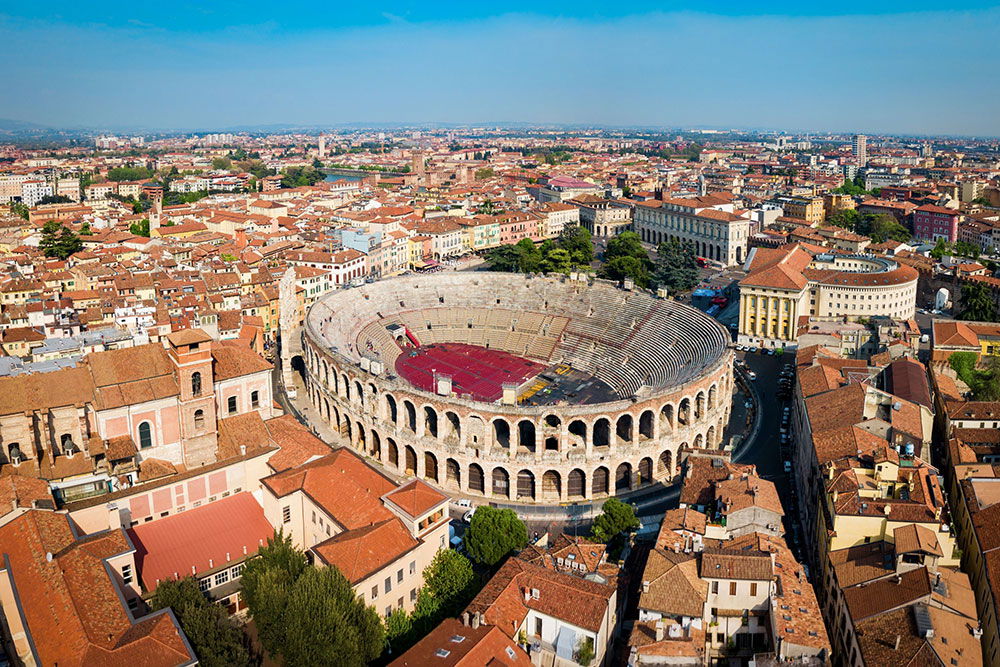
In the heart of Verona, a city steeped in romance and Renaissance beauty, stands one of the most remarkable Roman monuments in the world, the Arena di Verona. Built nearly 2,000 years ago, this incredibly well-preserved Roman amphitheatre is not only a window into ancient history but also a thriving center for modern culture, especially opera and live concerts.
Today, the Arena draws visitors from across the globe, captivated by its timeless architecture and unforgettable performances under the stars.
The Verona Arena was constructed in 30 AD, during the reign of Emperor Augustus. It was built just outside the ancient city walls using pink and white limestone from Valpolicella, a nearby region still famous today for its wine.
Originally designed to host gladiatorial contests, hunts, and public spectacles, the amphitheatre could hold over 30,000 spectators, making it one of the largest in the Roman Empire.
Unlike many ancient sites that have been lost to time or destruction, the Arena di Verona remains remarkably intact. Although an earthquake in 1117 destroyed the outermost ring, much of the inner structure has survived, offering a rare glimpse into Roman engineering brilliance.
The Arena’s elliptical shape, measuring 139 meters long and 110 meters wide, was designed to offer perfect visibility and acoustics from every seat—something it still achieves today. Visitors are struck by the massive stone seating, intricate corridors, and the sense of grandeur that permeates the space.
The city of Verona has taken great care to preserve the monument, and it remains a UNESCO World Heritage Site as part of the historic center of Verona. Restoration projects continue to ensure the amphitheatre remains both historically authentic and safe for modern use.
While the gladiators are long gone, the Arena has been reborn as one of the world’s most iconic open-air opera venues. Since 1913, when the Arena hosted a grand performance of Aida to mark the centenary of Giuseppe Verdi’s birth, it has become a cornerstone of global opera culture.
Each summer, the Arena di Verona Opera Festival transforms this ancient space into a majestic performance venue. The festival is:
The acoustics of the Arena are so refined that many performances proceed without microphones, just as in Roman times.
With seating for 15,000 modern guests, spectators can choose between the original stone steps or upgraded seats, and enjoy world-class performances under a Veronese sky.
Beyond opera, the Arena also hosts a wide variety of cultural events, including:
This dynamic use makes the Arena a living monument, where ancient history meets contemporary art.
Whether you are a history lover, architecture enthusiast, or music aficionado, visiting the Arena di Verona is a must. Here are some quick tips for planning your visit:
Opening Hours: Typically open daily from 9:00 AM to 7:00 PM (check seasonal changes)
Tickets: Available on-site and online; opera performance tickets sell out months in advance
Guided Tours: Highly recommended to understand the Arena’s layered past
Location: Piazza Bra, Verona – easily accessible from Verona Porta Nuova station
The best time to experience the Arena is during the summer opera season, running from June to September. However, even outside the festival period, the amphitheatre is open for daytime tours and makes for an unforgettable experience
.Verona is famous as the setting for Shakespeare’s Romeo and Juliet, but its real-life stage is the Arena. It captures the heart of what makes Italy so extraordinary: deep historical roots, a love of art, and a celebration of life through music and culture.
As you walk through its arches and feel the stone beneath your feet, you are walking the same paths as Romans did two millennia ago. And when the sun sets and the overture begins, the past and present merge into something truly magical.
The Arena di Verona is far more than an ancient amphitheatre. It’s a place where Roman history, Italian culture, and world-class performance come together. Whether you visit by day or attend a moonlit opera, the Arena offers a unique journey through time.

More Details



